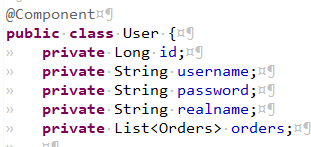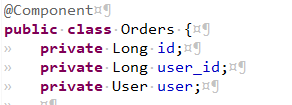什么是一对一,一对多,多对多?
以用户和订单举例,
一对一 : 一个订单只属于一个用户 ==> 订单对用户是一对一关系
一个用户只能有一个订单 ==> 用户对订单是一对一关系
一对多 : 一个用户可以拥有多个订单 ==> 用户对订单是一对多关系
多对多 : 一个订单可以有多种商品,并且一种商品可以被多个订单包含 ==> 商品和订单是多对多关系
数据库和实体(POJO)的设定
user表

oders表

User类(省略geter&seter)

Oders类(省略geter&seter)

下面用实例讲解一对一和一对多,只展示Mapper映射文件内容,Dao,Service,Controller层内容省略
一对一
一个订单对应一个用户,即一对一(订单对用户是一对一)
在POJO上的实现是,Orders类内包含一个User属性
现在我们用订单id来查询订单和对应用户的数据(关联查询)
如果用resultType的写法,myBatis就不能将查询结果绑定到Orders的user对象内,如下图,

运行后oders对象内的user属性将为null,Oders类内定义的其他属性可以正常赋值
为了解决这个问题,我们可以用resultMap来替代resultType
有两种实现方法,一种是嵌套结果,一种是嵌套查询
一.嵌套结果
<select id="getOrderAndUserByOrderId" resultMap="ordersAndUser">
SELECT * FROM orders o, user u WHERE o.user_id=u.id AND o.id=#{id}
</select>
<!-- 这是resultMap -->
<resultMap type="com.jy.entity.Orders" id="ordersAndUser">
<id property="id" column="id"/>
<result property="user_id" column="user_id"/>
<!-- 这是映射 -->
<association property="user" javaType="com.jy.entity.User">
<id property="id" column="id" />
<result property="username" column="username"/>
<result property="password" column="password"/>
<result property="realname" column="realname"/>
</association>
</resultMap>
<resultMap> :
type ==> Orders类的路径
id ==> resultMap名
<association> :
property ==> Orders类内user属性名
jayaType ==> user的类路径
二.嵌套查询
<select id="getOrderAndUserByOrderId" resultMap="ordersAndUser">
SELECT * FROM orders where id=#{id}
</select>
<resultMap type="com.jy.entity.Orders" id="ordersAndUser">
<id property="id" column="id"/>
<result property="user_id" column="user_id"/>
<!-- column是传的参数, select是调用的查询 -->
<association property="user" column="user_id" select="getUserById"/>
</resultMap>
<select id="getUserById" resultType="user">
SELECT * FROM user WHERE id=#{user_id}
</select>
<association> :
property ==> Oders类内的user属性
column ==> 调用查询时传入的参数
select ==> 调用的查询语句
通过以上的嵌套结果或嵌套查询的方法,即可成功为Oders内的user属性赋值!
一对多
一个用户有多个订单,即一对多(用户对订单是一对多)
<select id="getUserAndOrdersByUserId" resultMap="UserAndOrders">
SELECT u.id uid, u.username, u.password, u.realname, o.id, o.user_id
FROM user u, orders o
WHERE u.id=o.user_id AND u.id=#{id}
</select>
<resultMap type="com.jy.entity.User" id="UserAndOrders">
<id property="id" column="uid"/>
<result property="username" column="username"/>
<result property="password" column="password"/>
<result property="realname" column="realname"/>
<collection property="orders" ofType="com.jy.entity.Orders">
<id property="id" column="id"/>
<result property="user_id" column="user_id"/>
</collection>
</resultMap>
<collection> :
property ==> User类中的orders属性
ofType ==> Orders类路径
注意!
订单只能查询到一条结果??
用户和订单的id值如果名字一样的话,会发生冲突!这样查询结果中只会有一个订单,查不到所有订单!
解决办法 : 在SQL文中给其中一个id起别名,然后在column属性中输入别名!!
多对多
使用中间表来操作,省略
总结
1.不管是一对一还是多对多,都要使用<resultMap> ,属性有id 和type
2.一对一中,<resultMap>内要用<association>来映射复杂对象,属性有 :
(property和javaType) ==> 嵌套结果
(property, column, select) ==> 嵌套查询
3.一对多中,<resultMap>内要用<collection>来映射复杂对象,属性有property和ofType
4.注意防范<resultMap>和<association>或<collection>中字段名冲突的问题!
f